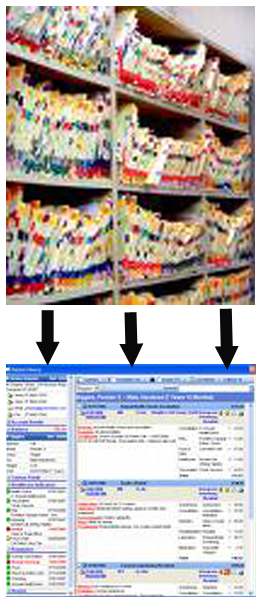
My never-ending nightmare: trying to provide high quality, efficient error-free medical care using today's health care electronic medical records (EMR). Whatever is the opposite of user-friendly information technology (IT), that is what people in healthcare face every day.
This morning, I couldn't see the old (archived) X-ray to compare it with today's. The computer near where I saw patients could not communicate with the computer where the echo studies were stored that I needed. I forgot which of my 14 (!) passwords was correct for the lab values program. I won't go on with my frustrations. If you are one the 6+ million health care providers in the USA, you know exactly what I mean.
Previously, writing about EMR, I plagiarized Nike writing: "Just Do It!" Maybe I need to say it louder, clearer and differently.
JUST DO IT, BUT DO IT RIGHT.
Providers have straightforward, relatively simple information technology needs for EMR. We want rapid, easy access anywhere to all patient medical information and built-in checks that error-proof the system. That's it. Computer experts say this is not hard, even with high- grade security built in.
It only becomes complex when people overlay additional agendas, mandatory constraints, and design-without-end-user.
I can access my Excel spreadsheets on either MAC or PC but I cannot see a chest X-ray and lab results using the same program. Inpatient files are coded (and secured) separately from outpatient records making it impossible easily to compare them. Does a patient change identity or illness when exiting the hospital door?
I will not regale you with the reasons why we don't have a good EMR system. The Obama administration is encouraging the development of EMR and that is wonderful. The scary part is that I know they will do it wrong. They will do "business as usual" (B.A.U. from the title). As a colleague on Twitter wrote recently, "IT tends to focus on back-end programming and loses sight of the front-end [the users]. Without usability, software is [and EMR will be] useless."
Ever seen an iPhone screen? It is simple, easy to read and easier to use. There are a small number of action choices on any one screen. Contrast to the screen in the hospital on which I am supposed to electronically sign my letters: it has 74 icons! Talk about incomprehensible. The needs of the end-users must drive the design.
We should not be constrained by legacy systems or concerns. As I have written previously, the only good legacies are money and good will. I am sorry if people have sunk billions into stand-alone EMR systems with strong fire-walls. The one (just one) system that we need is totally inter-operable, easily usable everywhere, and fast. If we let legacy systems constraint EMR, we will have patches on top of patches requiring reconciliation and translation programs. That won't work, not for us anyway.
There is a tendency to accept as a given other constraints in addition to legacies. For instance, regulators demand that the system be HIPAA-compliant and that it limit access to information on mental disorders, STDs or genetics. That is like starting a race wearing cement running shoes.
Security of medical information will always be a concern and security precautions must be incorporated into any system. However, when security dominates design, it impairs communication. That leads to inefficiency and worse, to errors.
The way to optimize an EMR system is straightforward but not easy. Whatever facilitates information exchange or prevents errors is automatically acceptable. Anything - and I do mean anything - else must first be subjected to cost/benefit analysis based on evidence before incorporation into any EMR system.
What has happened to date is: substitution of logic for evidence; limiting immediate cost with no consideration for long term consequences; purchase of stand-alone systems that are impossible to use; and prevention of communication in the name of security. RESULT: where we are now - the providers' ongoing medical information nightmare.
EMR must be done right. "Business as usual" won't cut it.